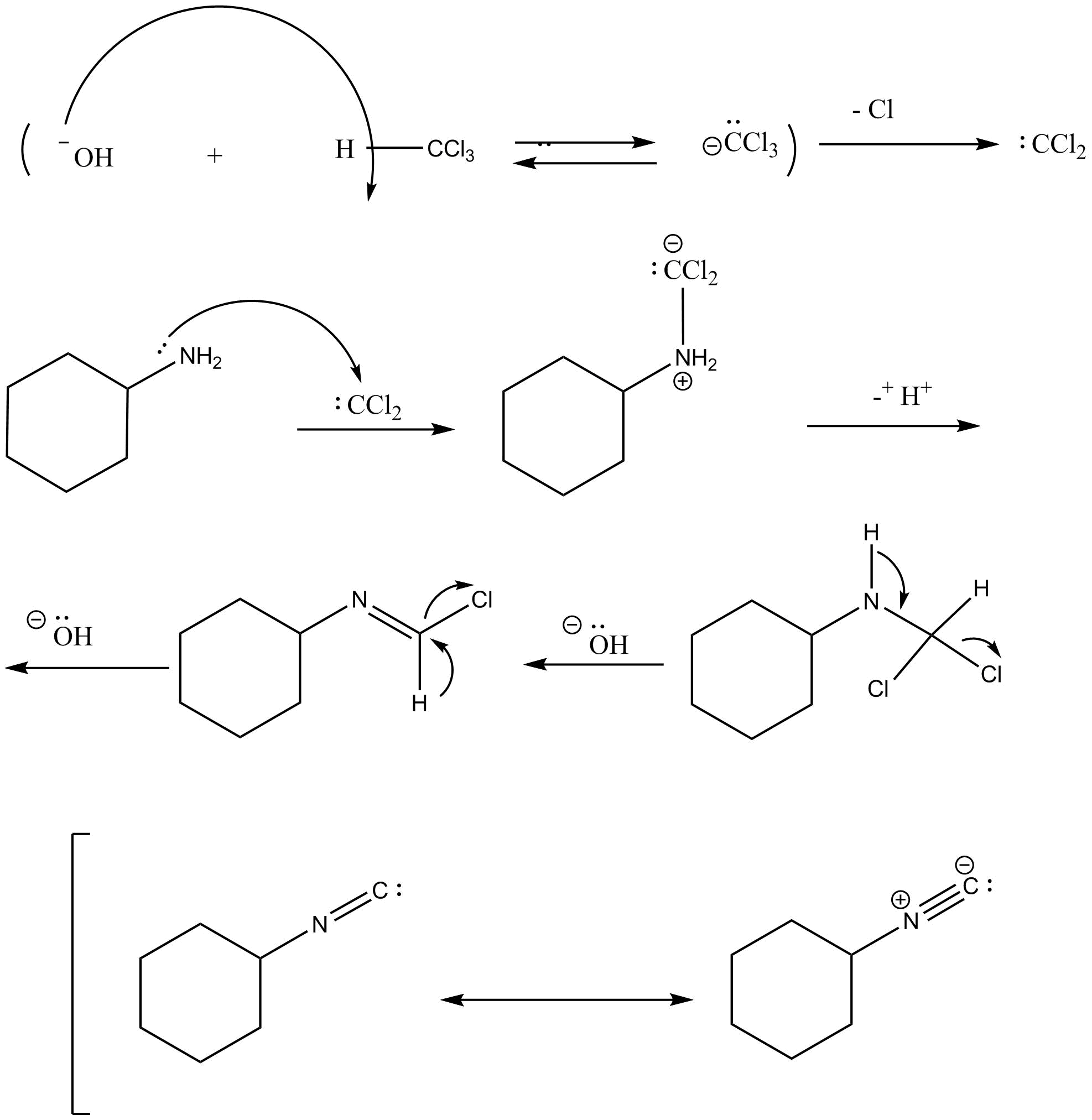
Answer
428.7k+ views
Hint: This question gives the knowledge about the carbylamine reaction. This reaction is also called as Hoffman’s isocyanide test which is responsible for the detection of primary aliphatic and aromatic amines.
Complete step by step answer:
Carbylamine reaction is also called as Hoffman’s isocyanide test which is responsible for the detection of primary aliphatic and aromatic amines. This reaction involves the formation of carbene intermediate. Secondary amines and tertiary amines do not give positive Hoffman’s isocyanide test. Isonitrile is also known as isocyanide. Isocyanide is a chemical compound having functional group $\left( { - C \equiv N} \right)$. This reaction involves the formation of carbene intermediate which is a short lived neutral species. Carbenes are of two types, which are singlet carbene and triplet carbene.
Mechanism of the carbylamine reaction is as follows:
In the first step, dehydrohalogenation of chloroform takes place in which hydroxide ion reacts with chloroform and abstracts the hydrogen and removes the chloride ion and leads to the formation of carbene intermediate namely dichlorocarbene. The dichlorocarbene is highly reactive in nature.
In the next step, dichlorocarbene reacts with amine followed by two consecutive base catalyzed dehydrochlorination steps which leads to the formation of isocyanide. In this step, dichlorocarbene is an electrophile and amine is a nucleophile.
In the next step, removal of hydrochloric acid takes place and leads to the formation of isonitrile which is also known as isocyanide.

Note: Always remember the mechanism of carbylamine reaction. And also remember how the formation of carbene intermediate takes place. Hoffman’s isocyanide test is responsible for the detection of primary aliphatic and aromatic amines.
Complete step by step answer:
Carbylamine reaction is also called as Hoffman’s isocyanide test which is responsible for the detection of primary aliphatic and aromatic amines. This reaction involves the formation of carbene intermediate. Secondary amines and tertiary amines do not give positive Hoffman’s isocyanide test. Isonitrile is also known as isocyanide. Isocyanide is a chemical compound having functional group $\left( { - C \equiv N} \right)$. This reaction involves the formation of carbene intermediate which is a short lived neutral species. Carbenes are of two types, which are singlet carbene and triplet carbene.
Mechanism of the carbylamine reaction is as follows:
In the first step, dehydrohalogenation of chloroform takes place in which hydroxide ion reacts with chloroform and abstracts the hydrogen and removes the chloride ion and leads to the formation of carbene intermediate namely dichlorocarbene. The dichlorocarbene is highly reactive in nature.
In the next step, dichlorocarbene reacts with amine followed by two consecutive base catalyzed dehydrochlorination steps which leads to the formation of isocyanide. In this step, dichlorocarbene is an electrophile and amine is a nucleophile.
In the next step, removal of hydrochloric acid takes place and leads to the formation of isonitrile which is also known as isocyanide.

Note: Always remember the mechanism of carbylamine reaction. And also remember how the formation of carbene intermediate takes place. Hoffman’s isocyanide test is responsible for the detection of primary aliphatic and aromatic amines.
Recently Updated Pages
Who among the following was the religious guru of class 7 social science CBSE

what is the correct chronological order of the following class 10 social science CBSE

Which of the following was not the actual cause for class 10 social science CBSE

Which of the following statements is not correct A class 10 social science CBSE

Which of the following leaders was not present in the class 10 social science CBSE

Garampani Sanctuary is located at A Diphu Assam B Gangtok class 10 social science CBSE

Trending doubts
A rainbow has circular shape because A The earth is class 11 physics CBSE

Which are the Top 10 Largest Countries of the World?

Fill the blanks with the suitable prepositions 1 The class 9 english CBSE

How do you graph the function fx 4x class 9 maths CBSE

What is BLO What is the full form of BLO class 8 social science CBSE

The Equation xxx + 2 is Satisfied when x is Equal to Class 10 Maths

Give 10 examples for herbs , shrubs , climbers , creepers

Difference between Prokaryotic cell and Eukaryotic class 11 biology CBSE

Change the following sentences into negative and interrogative class 10 english CBSE





